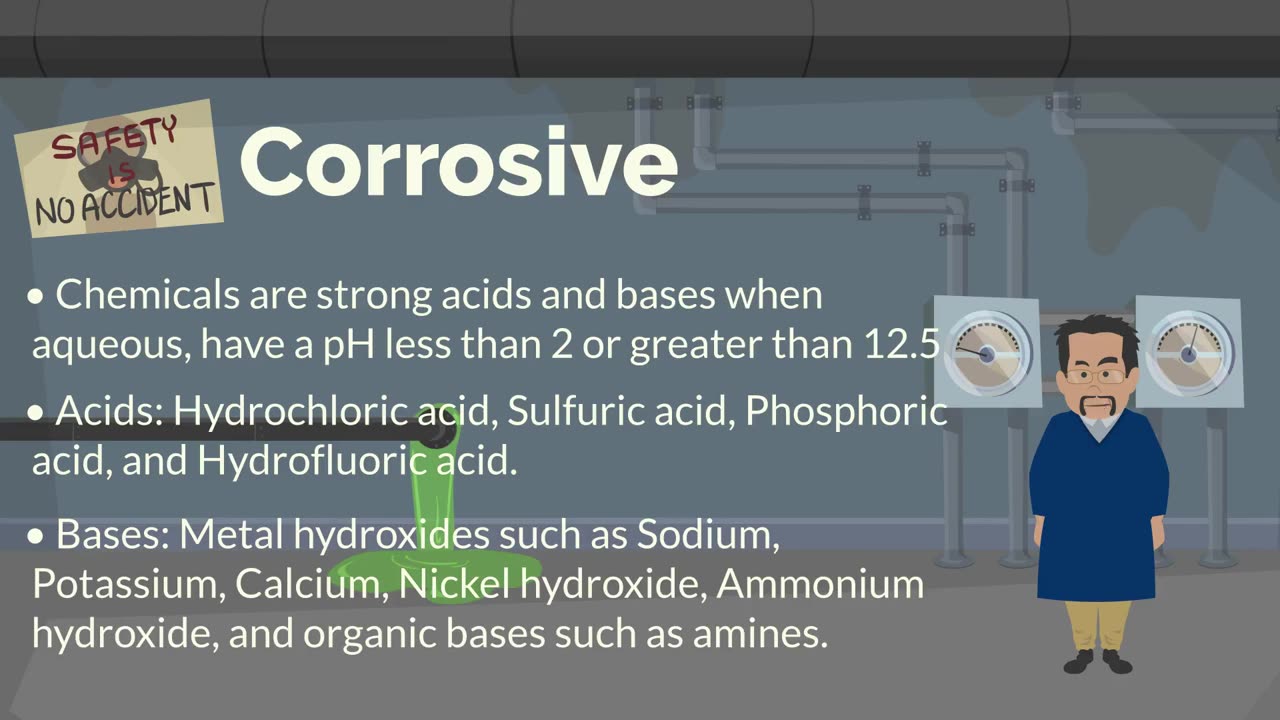Premium Only Content

Chemical Hazard Recognition_ TRIC
**Chemical Hazard Recognition: TRIC**
The acronym **TRIC** can be used as a systematic approach to recognize and address chemical hazards. It stands for **Toxicity, Reactivity, Ignitability, and Corrosivity**. Here's how each component helps in chemical hazard recognition:
---
### **1. Toxicity**
- **Definition**: The potential of a chemical to cause harm to living organisms through inhalation, ingestion, or skin contact.
- **Indicators**:
- Pictograms or labels indicating "Toxic," "Harmful," or "Dangerous."
- Consult the Safety Data Sheet (SDS) for information on lethal doses (LD50) and permissible exposure limits (PEL).
- **Recognition**:
- Examples: Carbon monoxide, cyanide, and pesticides.
- Observe symptoms like dizziness, nausea, or irritation.
---
### **2. Reactivity**
- **Definition**: The chemical's tendency to react violently or release energy when exposed to certain conditions (e.g., heat, water, or other chemicals).
- **Indicators**:
- Terms like "Unstable," "Explosive," or "Reactive" on labels.
- SDS section on stability and reactivity.
- **Recognition**:
- Examples: Sodium reacts with water; peroxides are shock-sensitive.
- Look for storage warnings like "Keep away from heat or incompatible substances."
---
### **3. Ignitability**
- **Definition**: The ability of a chemical to catch fire under certain conditions.
- **Indicators**:
- Flashpoint data on the SDS.
- Flammable or combustible warnings.
- Pictograms like the flame symbol.
- **Recognition**:
- Examples: Gasoline, ethanol, and acetone.
- Check for proper grounding and storage in fire-safe cabinets.
---
### **4. Corrosivity**
- **Definition**: The ability of a chemical to destroy or irreversibly damage materials, including skin and metals.
- **Indicators**:
- Pictograms or warnings indicating "Corrosive."
- SDS sections on handling precautions.
- **Recognition**:
- Examples: Sulfuric acid, sodium hydroxide, and hydrochloric acid.
- Observe physical signs of damage to containers or PPE.
---
### **Application of TRIC in Safety**
1. **Assessment**: Use TRIC to evaluate the potential risks of chemicals during storage, transportation, and usage.
2. **Training**: Educate employees about recognizing hazards and understanding labels and SDS.
3. **Controls**: Implement engineering controls (e.g., fume hoods), administrative controls (e.g., safe work practices), and PPE to mitigate risks.
Would you like this concept expanded into a training presentation or animation script?
-
 19:56
19:56
inspirePlay
1 day ago $0.52 earnedWalking with Lions & Facing Africa’s Wild Side | Safari Adventure with the Grid Championship Crew!
20.6K1 -
 10:50
10:50
RTT: Guns & Gear
2 days ago $1.33 earnedBudget Friendly Carry 2011: EAA Girsan Brat 2311
20.1K6 -
 3:49:06
3:49:06
Alex Zedra
18 hours agoLIVE! New Game | Nuclear Nightmare
109K14 -
 25:08
25:08
MYLUNCHBREAK CHANNEL PAGE
1 day agoUnder The Necropolis - Pt 2
291K85 -
 1:45:59
1:45:59
Spittin' Chiclets
1 day agoCanadian Chokejob - Game Notes Live From Chicago - 12.28.2024
267K32 -
 9:18
9:18
Space Ice
1 day agoThe Guyver - Alien Bug Suits, Exploding Dragons, & Mark Hamill - Weirdest Movie Ever
171K27 -
 9:31
9:31
Silver Dragons
2 days agoSilver Has Failed - Can it Set the Record Next Year? THIS BANK SAYS YES!
7.57K2 -
 7:08
7:08
GBGunsRumble
20 hours agoGBGuns Range Report 28DEC24
4.24K1 -
 1:19
1:19
LimitlessAmbition
8 hours ago $0.17 earnedHow the Discipline of Self-Respect Will Change Your Life Forever
3.07K -
 12:46
12:46
RealReaper
2 days ago $9.46 earnedMufasa is a Soulless Cash Grab
97.7K13